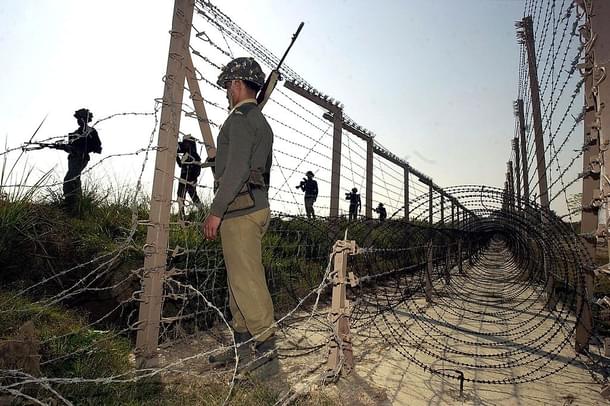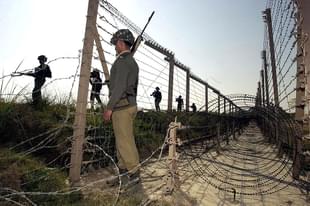Defence
The LOC Is Hyper Active. But Why At Uri?
Syed Ata Hasnain
Mar 07, 2018, 12:48 PM | Updated 12:48 PM IST
Save & read from anywhere!
Bookmark stories for easy access on any device or the Swarajya app.


Fifteen years after they fell silent, artillery guns are ablaze once again at Uri, one of the best known sectors based on a big name town on the geographical spread of the Line of Control (LoC) between India and Pakistan. Uri is immediately north of the Pir Panjal. In 2003 and prior, it was routine here for both sides to target posts, picquets and logistics routes with a plethora of military wherewithal including guided missiles, sniper rifles and most importantly artillery guns. Much of this affected the civilian gentry too who bore this with clenched teeth and much trepidation. In the interim, brief exchanges of small arms fire have occurred infrequently. Use of mortars was briefly resorted to in 2012-13 when the Indian Army laid low some Pakistani attempts to brow beat it on the legitimate construction of bunkers on our side of the LoC at a crucial post. In fact, it was that incident which commenced the spiral of actions on the LoC from 2013 onwards in the Jammu region, south of the Pir Panjal, to include Poonch, Mendhar and Rajouri.
So why has such intense action returned to Uri? A few clarifications about the latest situation and then a short brief on the terrain will help understand this better. There have been intense exchanges of fire along the LoC with some cross LoC actions through 2017 and early 2018, mainly south of the Pir Panjal range. The Indian Army’s response has been strong and professional although, as can be expected, there have been losses on our side too. Our assessment has always been that such firing is linked to infiltration, but infiltration in Pir Panjal South has been almost negligible, confirmed by very low terrorist activity. It is also evident that LoC activation by Pakistan is to keep the Indian Army diverted in focus while infiltration is attempted in the Valley’s LoC sector.
Geographically, Uri is a bulge towards Pakistan occupied Kashmir (PoK), and the sector is divided north and south almost equally by a major obstacle, the River Jhelum. In conventional warfare terms, it is a natural objective for Pakistan, being easier to address through two prongs either side of the river, from north and south into the salient. It is also detached from the main Valley; a western limb. In addition, it is an area which offers terrain from as low as 4000 feet to heights up to 14500 feet. Thus it is vulnerable to infiltration right through the year; the higher reaches opening in June every year.
Uri is also an area populated in majority by Paharis and Gujjars, not traditionally favouring Pakistan. In all three major conflicts between India and Pakistan, 1947-48, 1965 and 1971, this population assisted the Indian Army in considerable measure, notwithstanding that in the last couple of years some of the best guides for infiltration have also come from the same communities primarily for a price. Areas such as Lipa and Tangdhar being further from the proximity of the main Valley offer comparatively less lucrative objectives, although equally if not more important infiltration avenues. Thus diversion in Uri while attempting infiltration along those avenues does make sense. This year the snowfall has been the lowest in living memory thus opening up the window for early infiltration to make up the numbers in the Valley to allow a full season of terror activities.
For Pakistan, it also makes sense to activate the Valley LoC to directly affect 15 Corps, the Indian Army formation responsible for the military domain in the Valley but to what extent is a moot point? Going beyond a threshold will get the Indian Army to respond in areas where it has a decided advantage. In the Lipa sector, there is no population on our side while the Pakistan brigade headquarters can be viewed from almost all our posts along with a large number of villages. In Tangdhar sector, the quantum of population on both sides is almost equal but, it’s the area of the Nilam Valley from Tithwal to Keran where the full advantage lies with India. There is much lesser population on our side of the LoC while the PoK side has much of it. The Nilam Valley road, which is the shortest logistics supply route to the Pakistani formations deployed in the north, is completely open to targeting by the Indian Army’s dominant positions. Closure of this route imposes a heavy penalty in time and effort in resupplying the Pakistan Army deployment in the north through three bypasses.
Therefore Uri is a testing ground, and testing is what Pakistan is doing along with diversion of attention to effect early infiltration in preparation for the 2018 campaigning season. That only the south Jhelum sub-sector and that too only a part of it has been activated stands testimony to the above analysis. Here there is population close to the LoC on our side (a thousand people have fled to safer places) but none on the PoK side; further north in the Uri sector there is a much larger population on both sides. Indian Army’s response has rightly been calibrated, and there is no attempt at horizontal escalation. But vertical escalation has been swift, extremely professional and involved even the employment of artillery for the first time in fifteen years. Horizontal escalation will unnecessarily divert more attention and only if Pakistan continues its mind games will the necessity arise to take the escalation to Lipa and Nilam Valleys with heavy attrition on it.
The LoC is a strange place and operations based on it in a ‘no war-no peace’ scenario are extremely difficult to comprehend for even those in uniform who do not have the requisite experience of handling situations there. They are all about moral ascendancy and psychological one-upmanship besides the usual phenomenon of infiltration.
Uri is a ‘big name place’ and especially, after the 2016 suicide attack on the brigade headquarters, has become a natural objective to play mind games. Much is dependent even on local rivalries, attention-seeking gestures and attempts at browbeating. It cannot be forgotten that the newly appointed Corps Commander of 15 Corps is an ex DGMO whose responses in the field are being tested. The new General Officer Commanding of the division responsible for Uri sector is an old hand under whose earlier command of a brigade in the same sector the Pakistan Army unit opposite Uri was bloodied in 2012-13. Even when units of the two armies who have faced each other earlier meet again by sheer chance on the LOC, the rivalry is intense.
The LoC dynamics will continue; there are no winners and no losers here. Destruction and casualties are temporary situations and do not denote victory. From Uri North to Kargil and Siachen, the major part of the LoC is still peaceful. If Pakistan attempts any further escalation, our calibrated response should be qualitatively higher, heavier and more intense. The aim should be to limit diversion and achieve fully effective counter infiltration. Drying up the Valley of foreign terrorists and ensuring sufficient outreach to the population to prevent fresh recruitment of alienated youth is the larger aim which will prevent Pakistan from achieving its goals
The writer is a former GOC of India’s Srinagar based 15 Corps, now associated with Vivekanand International Foundation and the Institute of Peace and Conflict Studies.





